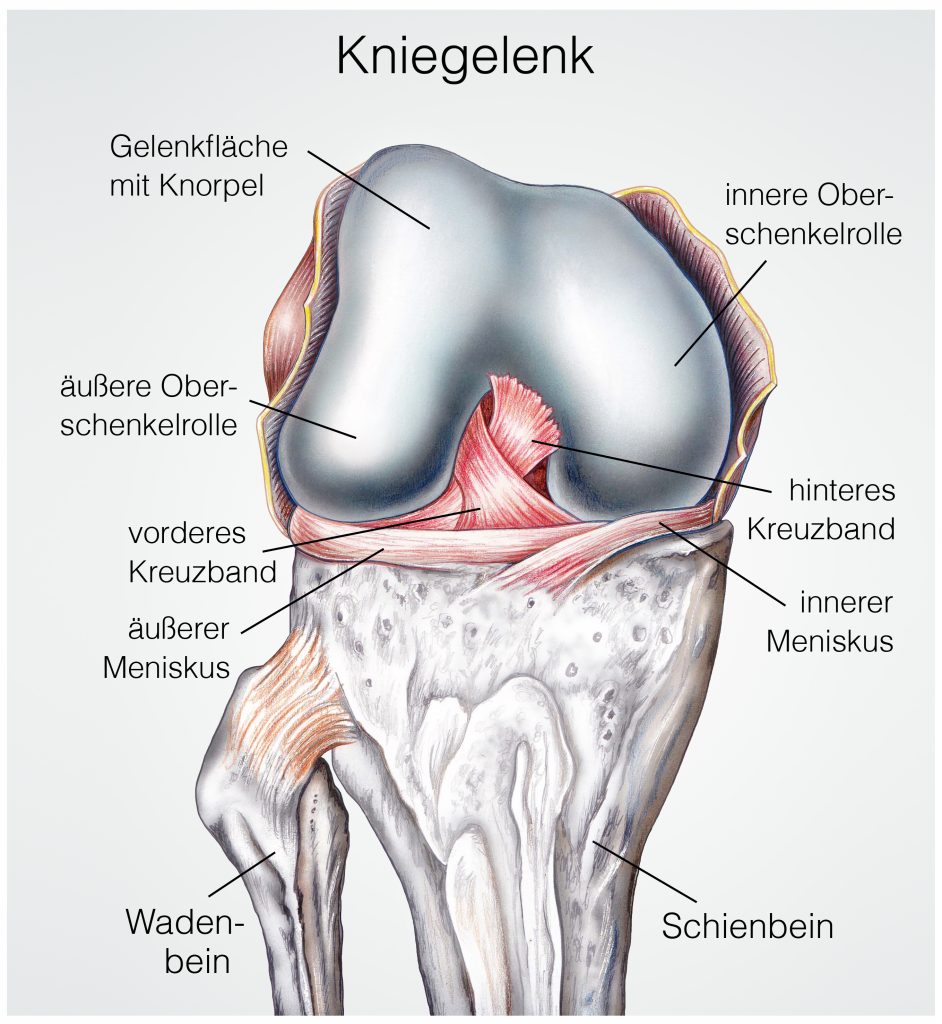Meniscus tear & meniscus surgery
Meniscus surgery Vienna
Acute care & follow-up treatment
ÜBERSICHT

Does a meniscus injury require surgery?
Not every meniscus needs to be operated on! This is an individual decision.
A freshly torn meniscus (also known as a meniscus lesion) must be carefully be carefully examined. One Magnetic resonance imaging shows us exactly where the meniscus is torn, how large the tear is and the shape of the meniscus tear. Based on this visualization and together with the clinical examination, we can then decide whether an operation makes sense.
If meniscus surgery is necessary, I usually try to preserve the meniscus and suture the tear (meniscus suture). The meniscus is ultimately an important structure in the knee without which premature wear and tear of the joint cartilage occurs. Due to the specific circulatory situation, the age of the meniscus tear and your own age, a meniscus suture is not always advisable. For this reason, damaged parts of the meniscus sometimes have to be removed to prevent further damage to the joint (partial meniscus resection).
Chronic meniscus wear
Chronic meniscus degeneration in the knee joint many people have even without having symptoms. Therefore the Conservative therapyThis is justified by physiotherapy and fascia therapy for 3 months. Only if this does not lead to the desired success can surgery still be considered. If there is an extension deficit in the knee joint, it must be assumed that the meniscus is trapped, which should be treated surgically as soon as possible, as this can result in cartilage injuries.

Meniscus therapy is a complex issue and must be adapted to the individual patient. Your MRI, your symptoms and the clinical examination in my practice must be brought together in order to offer you the best possible treatment. Basically, the motto is “Save the meniscus” and preserve as much meniscus tissue as possible.
What is a meniscus?
In short, the meniscus is a cartilage in the knee. The smooth surface of the meniscus prevents friction due to cartilage. The two menisci (inner and outer meniscus) lie between the cartilage layer of the thigh and lower leg and act as joint stabilizers and shock absorbers of the knee joint. Joint stabilizer and shock absorber of the knee jointas they increase the surface area of the contact surface. They have a crescent shape, consist of fibrocartilage and can therefore ideally distribute the load of the body weight in all degrees of flexion.
The outer meniscus (lateral meniscus) can move up to 2 cm forwards and backwards between extension and flexion.
The medial meniscus is less flexible as it is firmly attached to the joint capsule. This also makes it more susceptible to injury in the event of trauma. After a meniscus has been completely removed, the pressure peaks on the cartilage can increase 200-fold. The consequence is premature wear and tear of the joint with an increased risk of osteoarthritis developing.
Maintaining the meniscus tissue is therefore important for long-term good knee function.

Injury mechanism of a meniscus tear
Meniscus tears are one of the most common knee injuries and often occur in sports such as soccer.
Meniscus tears often occur during sport
An acute meniscus tear usually occurs with rotational injuries to the knee joint or excessive knee flexion. Sports with a lot of “stop and go” movements(soccer, basketball, volleyball, tennis, etc.) or rotational movements (skiing, full contact sports such as football, rugby, martial arts) are particularly at risk of suffering an acute meniscus tear.
Chronic meniscus injuries
The meniscus is often degeneratively thinned or fatty due to age, making it easier for a tear to occur.

Pain in the knee due to meniscus tear
Not every meniscus tear has to be painful, which is why a precise clinical examination is necessary. Recurrent bruising of the joint, pain, particularly when walking downhill or squatting low, are typical of a meniscus injury.
Sometimes parts of the meniscus are impacted in the knee joint space so that the joint can no longer be fully extended. This inhibition of extension is very painful and must be treated as quickly as possible, otherwise cartilage tissue will be destroyed prematurely.
Diagnosis of meniscus damage
During the clinical examination, specific tests can be used to determine whether a meniscus tear is suspected.
Magnetic resonance imaging(MRI) should always be carried out in the event of clinical suspicion, as this is the only way to assess the tear accurately.
The meniscus is divided into three zones due to its reduced blood supply and therefore also its reduced healing potential:
- The "RED ZONE" near the base is supplied by tiny blood vessels, which is why scarring is possible here after a meniscus suture.
- The last extensions of blood vessels can be found in the middle "RED-WHITE ZONE". A meniscus suture is also conceivable here.
- In the innermost "WHITE ZONE" close to the joint, there is no longer any blood circulation, which is why healing is no longer possible here.
Treatment of a meniscus injury
Since not all meniscus injuries are painful, not every meniscus needs to be operated on! This is an individual decision.
Many people have chronic meniscus degeneration even if they have no symptoms. Therefore, conservative therapy using physiotherapy and fascia therapy for 3 months is entirely justified. Only if this does not lead to the desired success can surgery still be considered. If there is an extension deficit in the knee joint, it must be assumed that the meniscus is trapped, which should be treated surgically as soon as possible, as this can result in cartilage injuries.

Partial meniscus resection
A symptomatic meniscus tear that is painful despite conservative treatment or causes pinching symptoms should be operated on. This is performed using the keyhole technique(arthroscopy) with only 2x 0.5 cm incisions.
If the tear is in the non-perfused white zone, chronically degenerated or so complexly torn that meniscus preservation is not possible, the damaged tissue is removed. This is done sparingly, as the aim is not to completely lose the buffer function of the meniscus. “As much as necessary, but as little as possible!”
After a partial meniscus resection, full weight bearing is possible after just a few days. Swimming and cycling can be resumed after 3 weeks. A general sports clearance can usually be given after 6 weeks following a partial removal.
Meniscus suture
A fresh tear in an athlete should be preserved as much as possible. Therefore, the indication for meniscus suturing should be given generously. Suturing can also be performed using the keyhole technique(arthroscopy) with incisions measuring just 2x 0.5 cm.
Depending on the size and shape of the tear, meniscus suturing is followed by customized follow-up treatment with physiotherapeutic care. A special splint(movement orthosis) is used to restrict mobility for 4-6 weeks. The load on the sutured meniscus must be taken off the leg for 6 weeks with 2 support crutches by relieving or partially loading the leg.
Subsequently, muscle building training is required. From a pain-free knee flexion of over 110°, you can train on the bicycle ergometer. Loose running training is usually only possible after 3 months. A general release for rotational sports should only be given 6-8 months after surgery. If you are not sure whether you should put weight on the operated leg or not, I am always available to answer your questions after your operation!
To prevent the early development of osteoarthritis, especially in athletes, the credo applies “Save the meniscus!”

Frequently asked questions about the meniscus
Meniscus changes can be detected in MRI scans in many people even without them having symptoms. Conservative therapy for chronic meniscus tears using physiotherapy and fascia therapy for 3 months is therefore entirely justified. Only if this does not lead to the desired success can surgery still be considered.
A fresh accidental tear in a young person should be preserved as well as possible. For a meniscus suture to be successful, it should be performed within the first few months. The indication for meniscus suturing should therefore be given generously.
A tear in a young person in an area with good blood supply can also heal by itself. Once a certain tear size has been reached, the meniscus becomes unstable and slips into the joint. The impacted meniscus is then responsible for restricting movement and inhibiting extension.
After a partial meniscus resection, you should use crutches for 1-2 weeks. After this, it is usually possible to return to work. People who work hard or who have had a meniscus sutureusually require longer rehabilitation.
Follow-up treatment after meniscus suturing should be accompanied by physiotherapy.
- After a meniscus suture, partial weight-bearing is usually necessary for approx. 6 weeks, depending on the type of tear.
- After this time, when the joint can be flexed up to 100°, bicycle ergometer training is possible.
- Running training can be started from the 3rd month.
- Approximately 4 months after the operation, a return to sport-specific training can be attempted.

